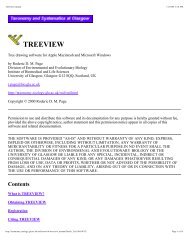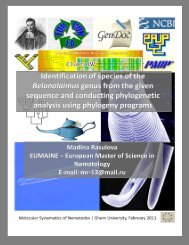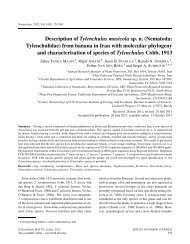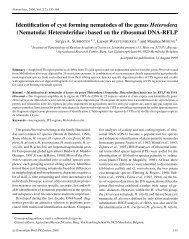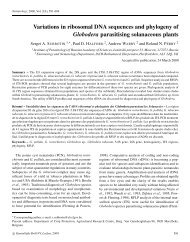Morphological and molecular characterisation of Californian species ...
Morphological and molecular characterisation of Californian species ...
Morphological and molecular characterisation of Californian species ...
You also want an ePaper? Increase the reach of your titles
YUMPU automatically turns print PDFs into web optimized ePapers that Google loves.
S. Álvarez-Ortega et al.<br />
ever, the most relevant point is that these three genera do<br />
not share a very recent ancestor, i.e., they are certainly not<br />
as closely related as currently assumed, Aporcelaimidae<br />
becoming a polyphyletic taxon. Unfortunately, the systematics<br />
<strong>of</strong> Aporcelaimidae is still in a transitional stage<br />
<strong>and</strong> further, more comprehensive, studies are needed to<br />
propose a new system for this dorylaimid group.<br />
Proposal <strong>of</strong> a new concept <strong>of</strong> the genus<br />
Metaporcelaimus<br />
The comparative, morphological analysis <strong>of</strong> Aporcelaimellus,<br />
if all its nominal <strong>species</strong> are included, <strong>and</strong><br />
Metaporcelaimus (see above) has not resulted in any significant<br />
difference between the genera yet has suggested<br />
an alternative option to distinguish them on the base <strong>of</strong><br />
cuticle structure <strong>and</strong> tail morphology, making necessary<br />
a new definition <strong>of</strong> these taxa. As a consequence, Metaporcelaimus<br />
is redefined below.<br />
DIAGNOSIS<br />
Metaporcelaimus Lordello, 1965<br />
Aporcelaimidae. Moderately slender to very slender nematodes<br />
(ratio a <strong>of</strong>ten exceeding 40 <strong>and</strong> seldom under 30)<br />
<strong>of</strong> medium to large size, 0.96-4.10 mm long. Cuticle typical<br />
dorylaimoid, two-layered. Lip region <strong>of</strong>fset by a more<br />
or less distinct constriction, seldom by depression. Odontostyle<br />
short, with wide aperture <strong>of</strong>ten occupying ca twothirds<br />
(60-70%) its length. Guiding ring simple, plicate.<br />
Odontophore rod-like. Pharynx enlarging gradually, with<br />
basal expansion occupying 42-64% <strong>of</strong> total neck length,<br />
S 1 N 1 very <strong>of</strong>ten slightly closer to DN than to S 1 N 2 . Female<br />
genital system didelphic-amphidelphic, pars refringens<br />
vaginae usually present, well developed. Vulva a<br />
transverse slit (V = 47-61). Tail similar in both sexes, conical<br />
with finely rounded terminus, always longer than anal<br />
body diam. (c ′ = 1.0-2.1), ventral surface straight, dorsal<br />
convex, inner core irregular <strong>and</strong> usually notched, <strong>of</strong>ten<br />
forming a long extension nearly reaching tail tip, inner<br />
cuticle layer not forming a continuous layer but bearing<br />
a terminal discontinuity at tail end. Spicules dorylaimoid.<br />
Ventromedian supplements 2-16 in number, widely separated,<br />
with or without hiatus.<br />
RELATIONSHIPS<br />
Metaporcelaimus is morphologically similar to Aporcelaimellus,<br />
from which it mainly differs in the morphology<br />
<strong>of</strong> the caudal region (Fig. 8) if compared to the first pattern<br />
<strong>of</strong> the latter genus (see above), i.e., conical with more or<br />
less rounded terminus vs hemispherical to convex conoid,<br />
longer than anal body diam. vs only exceptionally longer<br />
than anal body diam., intermediate cuticle layer poorly developed<br />
vs distinct <strong>and</strong> <strong>of</strong>ten defining a hyaline area at tail<br />
terminus, inner cuticle layer with vs without a terminal<br />
discontinuity <strong>and</strong> inner core <strong>of</strong>ten becoming notched <strong>and</strong><br />
irregular vs regular, very rarely notched, <strong>of</strong>ten forming a<br />
terminal extension almost reaching the tail tip vs no terminal<br />
digitation. In addition, Metaporcelaimus <strong>species</strong> are<br />
usually more slender, showing (when present) a poorly developed<br />
cervical lacuna vs <strong>of</strong>ten well developed, have an<br />
odontostyle with a larger aperture <strong>and</strong> have S 1 N 1 more anteriorly<br />
located. However, these features show a wide variability<br />
in the two genera <strong>and</strong> their diagnostic value should<br />
be taken with caution.<br />
Metaporcelaimus also resembles Aporcella (see new<br />
concept <strong>of</strong> this taxon by Álvarez-Ortega et al., 2013),<br />
but differs from the latter in the morphology <strong>of</strong> the tail<br />
(vs totally comparable to Aporcelaimellus in the nature<br />
<strong>of</strong> cuticle layers <strong>and</strong> inner core, see above), <strong>and</strong> pars<br />
refringens vaginae only exceptionally (vs always) absent.<br />
In some aspects it is also comparable to conical-tailed<br />
representatives <strong>of</strong> Qudsianematinae Jairajpuri, 1965, but<br />
differs in the odontostyle which is comparatively shorter<br />
<strong>and</strong> stronger (vs <strong>of</strong>ten 6-8 times as long as wide), <strong>and</strong> with<br />
a larger aperture (vs less than one-half <strong>of</strong> total length).<br />
REMARKS<br />
As mentioned, <strong>molecular</strong> data suggest that Metaporcelaimus,<br />
together with Sectonema, might be more closely<br />
related to qudsianematid <strong>and</strong> other dorylaimid taxa than<br />
to Aporcelaimellus, a question that should be matter for<br />
further studies in the context <strong>of</strong> a general revision <strong>of</strong> the<br />
Dorylaimina. In the meantime, <strong>and</strong> for practical reasons,<br />
it is kept under Aporcelaimidae.<br />
The new concept proposed for Metaporcelaimus puts<br />
special emphasis in the morphology <strong>of</strong> the caudal region<br />
to distinguish it from Aporcelaimellus, <strong>and</strong> this is the<br />
reason why several <strong>species</strong> are tentatively transferred, on<br />
the base <strong>of</strong> available information in the literature, from<br />
the latter to the former. This action results in two, more<br />
homogenous, genera.<br />
18 Nematology



